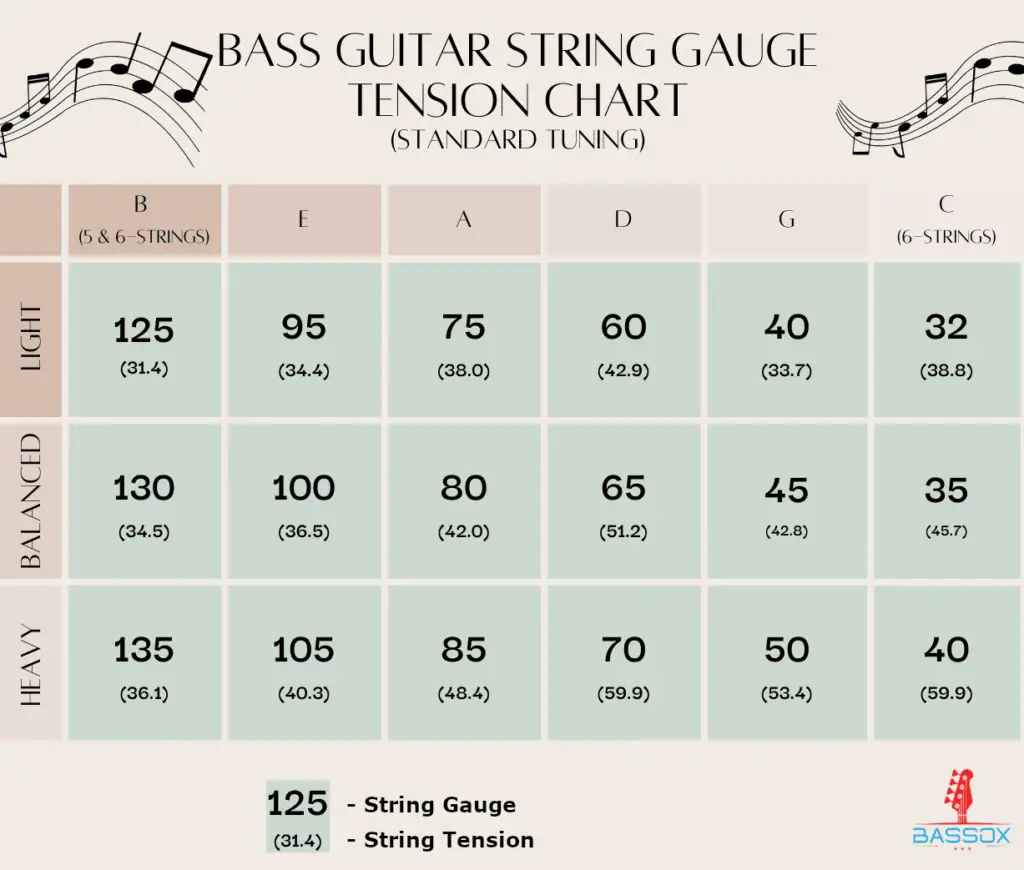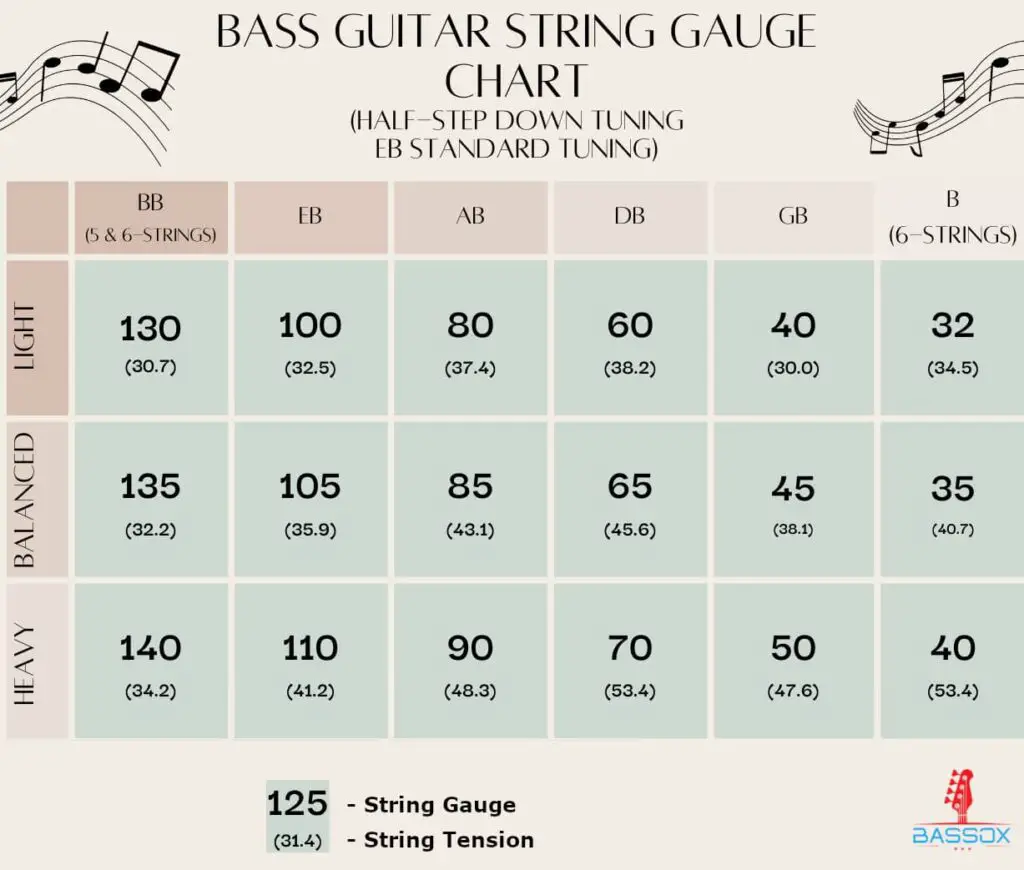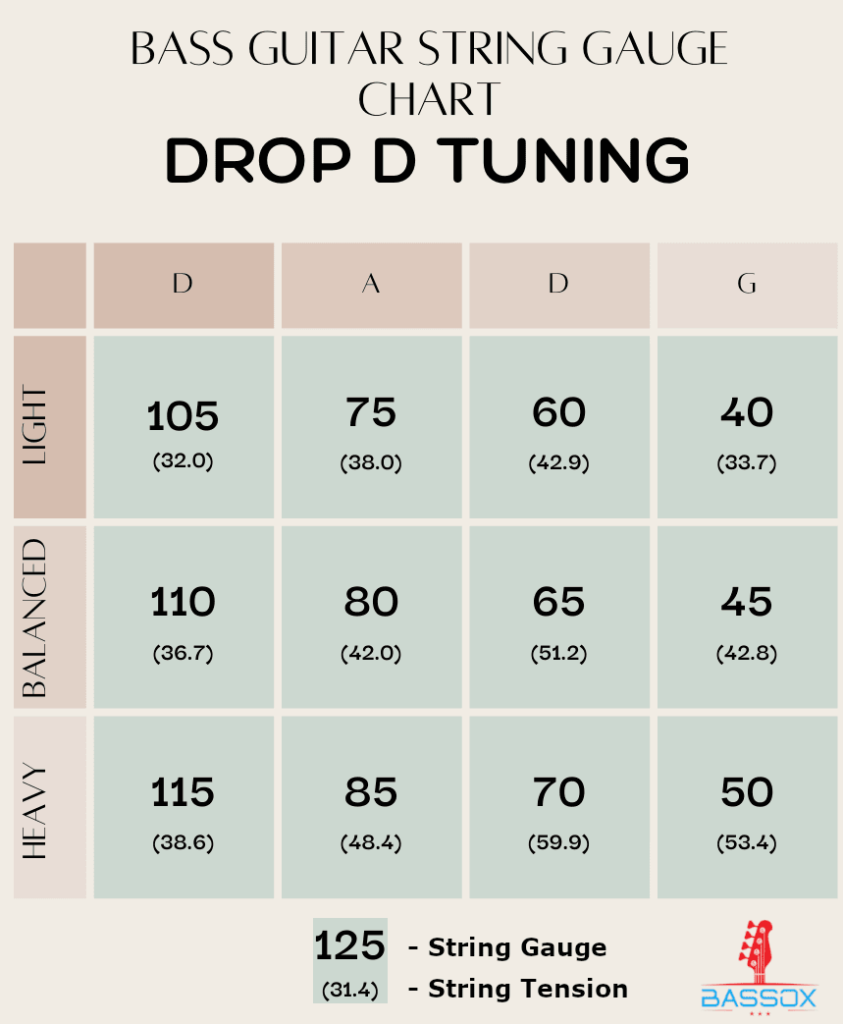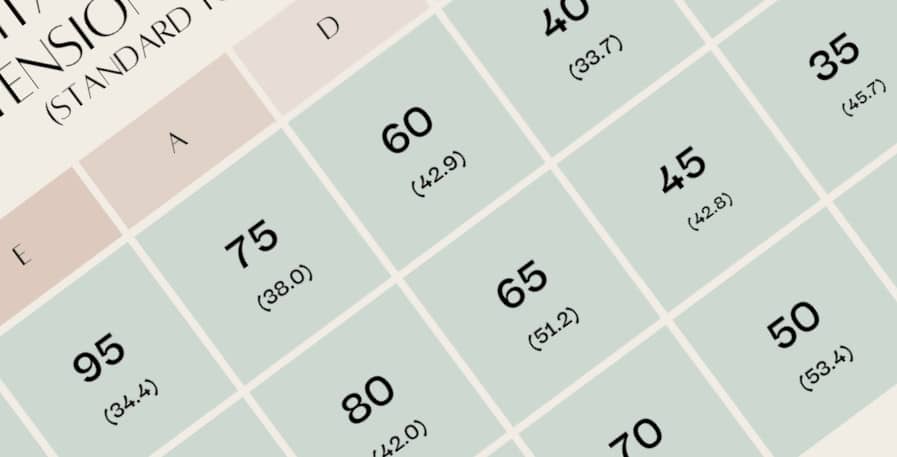The gauge of your bass strings has a massive impact on the sound and playability of your instrument.
Not only that, but the gauge of the strings has to be at least partly balanced. This is because the perfect E-string gauge won`t do much good if moving over to the A-string feels cumbersome and awkward.
That`s why I`ve made a couple of bass string gauge charts that will help you avoid this problem.
These charts can be used to calculate how much tension certain strings will hold. You can also use them to find out what gauge strings make up a light, balanced, or heavy set of bass strings.
Disclaimer: Bass string gauge differs between manufacturers. This is because the core and the wounding of the string affects how much tension the string will have.
For my charts, I have used data from Dàddario. This is because they are both a reputable and popular string brand. As DÀddario does not produce certain string gauges, I have also used information from Stringjoy.
Thus, unless you are intending to use D`Addario strings, consider these numbers approximations. There is no universal standard for tension among string manufacturers, and most manufacturers do not share this data.
Bass String Gauge Chart: E Standard
First of all, here`s a bass string gauge chart for E standard tuning. The chart assumes you play the common 34″ long-scale bass.
Below, I`ll show you how to read the chart if you are unfamiliar with string gauge and tension.

The string gauge is the same as the thickness of a bass string. String gauges are measured in 1/1000ths of an inch. This means that a 125 gauge bass string is 0.125 inches thick.
The thicker the gauge of a string is, the tenser it has to be strung. Personally, I`ve generally found thicker gauges easier to play for this reason. This is however subjective, and I`ve met many bassists who feel the opposite.
As for their tone, thin gauges produce a sharper and thinner tone. Vice versa, thicker gauges produce a heavier and warmer tone.
String tension tells us how many pounds of tension the strings hold.
Tension is a result of the gauge of the strings, the scale length of the bass, and what pitch the string is tuned to. The above chart assumes we are dealing with a 34″ long-scale bass, and are tuning it to E standard. Thus, the only variable that impacts the tension in the chart above is the string gauge.
When the string tension is low, the strings feel loose and slack. When the tension is high, the strings feel rigid and firm. If too much tension is put on the strings they will break; too little and they will rattle and have low amounts of sustain.
Individual bass string gauge guide
Next, here`s a bass string gauge chart that details the tension of individual strings. You can use this to put together a balanced set or to get a general idea of what strings you can use realistically use.
Note: If you are unfamiliar with how to use this information, I am going to go more in-depth about how to put together a string set below.
Let`s start off with a chart of how string tension changes when we change the gauge of the E string:
| E String Gauge | E String Tension |
| 120 | 50.8 |
| 115 | 48.5 |
| 110 | 46.2 |
| 105 | 40.3 |
| 100 | 36.5 |
| 95 | 34.4 |
| 90 | 30.5 |
| 85 | 27.2 |
And here`s a chart of how the tension of the A-string changes when we change the string gauge:
| A String Gauge | A String Tension |
| 90 | 54.2 |
| 85 | 48.4 |
| 80 | 42.0 |
| 75 | 38.0 |
| 70 | 33.7 |
| 65 | 28.8 |
| 60 | 24.1 |
Here`s a chart of how the string tension of the D-string changes:
| D String Gauge | D String Tension |
| 70 | 59.9 |
| 65 | 51.2 |
| 60 | 42.9 |
| 55 | 35.2 |
| 50 | 30.0 |
| 45 | 24.1 |
| 40 | 19.0 |
And here`s a chart for the G-string:
| G String Gauge | G String Tension |
| 55 | 62.6 |
| 50 | 53.4 |
| 45 | 42.8 |
| 40 | 33.7 |
| 35 | 25.7 |
| 32 | 21.8 |
Lastly, here is a chart for 5-string players on how the string tension of the B-string changes when we change the string gauge:
| B String Gauge | B String Tension |
| 145 | 41.5 |
| 140 | 38.2 |
| 135 | 36.1 |
| 130 | 34.5 |
| 125 | 31.4 |
| 120 | 28.6 |
| 115 | 27.1 |
| 110 | 26.0 |
Balanced VS Traditional string tension
As you might have noticed from the charts above, common string gauge sets have far from balanced amounts of tension.
This is because the volume that pickups pick up the sound of various bass strings differs. To make up for this, traditional bass string tension has put more tension on some strings over others. In particular, the D string often has noticeably more tension than the rest of the set.
This results in an uneven amount of tension, which can negatively affect playability. It also results in the volume sounding more even and a balanced tone, which can positively affect tone.
With that said, let`s take a look at what playing a perfectly balanced set of strings actually entails.,
Firstly, I found Lee Wrathe`s conclusion on using a balanced string interesting, here`s what he had to say:
I can`t really hear a massive difference tonaly in the room. It`s all about how they feel to me. I can tell a difference just in terms of evenness if I`m common picking.
Lee Wrathe – Balanced tension Vs Regular tension string Demo
Personally, I played with traditional string tension for close to a decade, not knowing there was an alternative. I have since tried out balanced sets that have close to the same tension across the strings.
I could see the appeal, and I did find the strings to feel more naturally balanced out. However, I also felt like I lacked some control in my playing and the upper strings in particular did feel a bit awkward to pick.
Thus, if I put in the effort of getting used to playing with a balanced set, I could see it making the bass more comfortable in the long run.
However, I have also grown accustomed to playing with traditional tension and don`t find that it hampers my playing. Therefore, switching to a balanced set is not worth it for me personally.
Bass string chart for alternate tunings
Lastly, It`s worth mentioning that what gauge strings, and how much tension they will hold depends on the tuning of the bass.
Above, I have solely talked about E standard, as this is the most commonly used bass tuning. However, if we tune the bass to another common tuning, Eb Standard, we get the following chart:

Given that Eb standard is just a half-step down from E standard, we can generally use the same strings for both tunings. However, they will hold a different amount of tension because of the change in pitch. Thus, while switching strings is often not necessary, it can be preferable.
Things get even more interesting when we look at drop tunings.
These are tunings where the deepest string is dropped an additional whole step down from standard tuning. The result is that the interval between the two deepest strings becomes larger, and we need a heavier string gauge to compensate for this.
As an example, here is a string gauge chart for Drop D bass tuning:

Notice how the difference in string gauge increases between the deepest and second deepest string. Despite this, the tension remains relatively similar to that of standard tunings.
Drop tunings are great for illuminating how pitch impacts string gauge and string tension. The above chart is also a great tool for bassists who are looking to try out alternate bass tunings.
Conclusion
By the end of the day, bass string gauge is subjective. Some bass players prefer heavy sets and others prefer light sets, without there being a clear answer to which is superior.
I can`t tell you what strings you will prefer or which will suit you the best. However, I can give you a general idea of what strings are made for a balanced set, and what a balanced set entails.
And that`s what I`ve tried to accomplish with the charts and with the information above.
To learn more about the differences between light and heavy bass strings, check out my Guide on Bass String Gauges. Here, I go more into the sound, tone, and playability of different string thicknesses.

